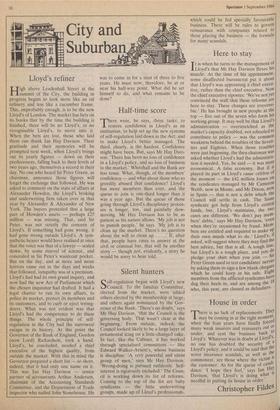City and Suburban
Lloyd's refiner High above Leadenhall Street at the summit of the City, the building in progress begins to look more like an oil refinery and less like a cucumber frame. This, improbably enough, is to be the new Lloyd's of London. The market has bets on its books that by the time the building is finished, there will be no Lloyd's, or no recognisable Lloyd's, to move into it. When the bets are lost, those who laid them can thank Ian Hay Davison. Their gratitude and their memories will be prompted next week, when Lloyd's brings out its yearly figures — down on their predecessors, falling back to their levels of two years ago, themselves a record in their day. No one who heard Sir Peter Green, as chairman, announce those figures will forget the exchange that followed. He was asked to comment on the state of affairs at Alexander Howden, the Lloyd's broking and underwriting firm taken over in that year by Alexander & Alexander of New York. The buyers protested that a large part of Howden's assets — perhaps £25 million — was missing. That, said Sir Peter, was not strictly the concern of Lloyd's. If something had gone wrong, it had gone wrong outside Lloyd's. A sym- pathetic hearer would have realised at once that the voice was that of a lawyer — scaled down, by some marvel of science, and concealed in Sir Peter's waistcoat pocket. But on the day, and as more and more horrors came out in the days and weeks that followed, sympathy was at a premium. Lloyd's had had its own grand inquiry, and now had the new Act of Parliament which the chosen inquisitor had drafted. It had a legal charter to run its own affairs, to police its market, protect its members and its customers, and to curb or eject wrong- doers. What was not evident was that Lloyd's had the competence to do these things. The whole principle of self- regulation in the City had the narrowest escape in its history. At this point the Governor of the Bank of England, Gordon (now Lord) Richardson, took a hand. Lloyd's, he concluded, needed a chief executive of the highest quality, from outside the market. With this in mind the Governor prepared a short list — so short, indeed, that it had only one name on it. This was Ian Hay Davison — senior partner of accountants Arthur Andersen, chairman of the Accounting Standards Committee, and the Department of Trade inspector who nailed John Stonehouse. He was to come in for a stint of three to five years. He must now, therefore, be at or near his half-way point. What did he set himself to do, and what remains to be done?










































 Previous page
Previous page